Here Come the Ducks
Bird enthusiasts and hunters wait for them every fall. Flocking to the Chesapeake from the prairie pothole region of north-central United States, south-central to northern Canada and Alaska, the ducks arrive. They dabble in our coves and lend their voices to the symphony of winter, harmonizing with the sonorous hooting of tundra swans and geese.
Though the vast numbers of the past are no longer, this year’s duck factory output has bird-lovers cheering.
The U.S. Fish and Wildlife Service 2012 Trends in Duck Breeding Population Report cites a record estimate of ducks across the U.S. and Canada: 48.6 million. That’s three million more quackers than last year, 43 percent above the long-term average. Despite fewer ponds and declining wetlands, waterfowl flocks soared.
Just who are these ducks?
Canvasback: Draped in sailcloth white with gleaming black bow and stern and brick-red sloping figurehead, this large, gregarious diver typically appears in rafts of tens to thousands. The origin of the common name is disputed, but their scientific name links the ducks, Aythya valisineria, to their favorite food: Vallisneria Americana, or wild celery. Canvasbacks posted high numbers this year, 33 percent above average.
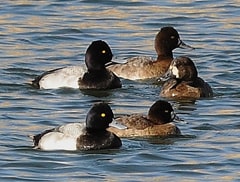
Greater and lesser scaup: Only slight subtleties to the shape of the head differentiate these look-alike species. Together, they are two of the most prevalent overwintering ducks on the Bay. Oreo-like, the males are dark on the ends and light in the middle, though grayer than the canvasback. The females’ chestnut heads with white-ringed bills offset their mottled brown bodies. Good numbers this year, up 21 percent from 2011 estimates.
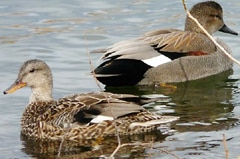
Gadwall: Subtle grey stippling covers the head and body of this understated male duck; wings sport an upper wash of brown, a flash of white at the base; tail is velvety black. Pair-bonded to mallard-resembling females during fall migration, these dabblers continue courtship here on the Bay, arching, fluffing and whistling. Primarily vegetarians in winter, gadwalls tip to eat grasses and reeds. They are also thieves, stealing from other ducks. Gadwall numbers are up 10 percent above 2011 estimates, a 96 percent increase of long-term averages.
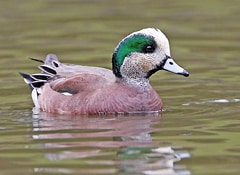
American wigeon: Called baldpate for their white forehead and crown, male wigeons are also known for their bright green Zorro mask, pink-brown body with white wing patch and black tail with white flanks. Vegetarian dabblers like gadwalls, wigeons are prone to thievery, typically snatching food from surfacing canvasbacks. A 1980s’ drought halved the population, but numbers are improving, with a three percent increase over 2011. That’s still 17 percent below their long-term average.

Green-winged teal: The small, swift-flying male stunner is easily recognized by his green swoosh from eye to base of neck across a chestnut-red head. A white vertical thumbprint on his shoulder is distinctive. Both males and the mottled brown females sport an iridescent green patch on wings and a buffy streak along their tails. These dabblers love seeds and grains and can be found in marshes and creeks, often stopping to glean in flooded fields. Numbers are up: 20 percent over 2011 numbers, 74 percent over long-term average.
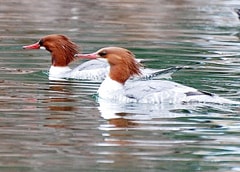
Mergansers: Lumped into one category in the Fish and Wildlife report, mergansers come in three species: common merganser, green-head with thin red-bill; red-breasted merganser, with shaggy green-head; and hooded merganser, noted for puffy white crest. The females of each species are shaped like their male counterparts but with reddish-orange heads. All are found on the winter Bay, though the hooded tend to be more secretive, tucked primarily in small wooded coves. Their populations were higher this year than in 2011.
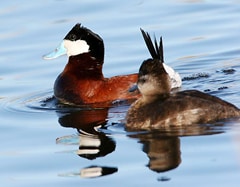
Two more migratory Bay ducks not included in the survey deserve mention because of their prevalence on our green winter waters.
Ruddy ducks are typically seen in rafts of hundreds to thousands. Muted grey in the fall, the males are recognizable by their small size, pale cheeks and upright tails. But keep your eye on them, for come spring they transform from drab to fab, decked out with handsome blue bills, chestnut bodies and white cheeks. If you are out boating on a still winter day and come upon a flock, listen for the spring rain sound they make on takeoff as hundreds of webbed feet run along the water’s surface.
Buffleheads scatter all over the winter Bay. Resembling small, flattened black-and-white balls, they are noted for their bouncy dives. Their courtships begin in early spring, with the males performing head bobs, jabs and scooting displays.
Don’t miss the fun! Grab a pair of binoculars and head out to the Bay. The ducks will be there.
Local Ducks
Two duck species breed here on the Bay.
We all recognize the ubiquitous mallards — the jade-headed male and camouflage-brown female — that nest in flower planters and under docks, parading their broods around the boats on Memorial Day and the Fourth of July. Their local population is stable, according to the Second Atlas of the Breeding Birds of Maryland and the District of Columbia. The U.S. Fish and Wildlife Service’s report found lowered numbers in the northeastern United States. But their numbers are strong in the pothole region: 10.6 million, 39 percent above average.
Our other primary Chesapeake breeder, the black duck, looks like a coal-covered mallard. Black duck numbers have fallen due to regional habitat loss, and local numbers are down. Fish and Wildlife reports an increase in the northeast, however, and some of those will winter here.
